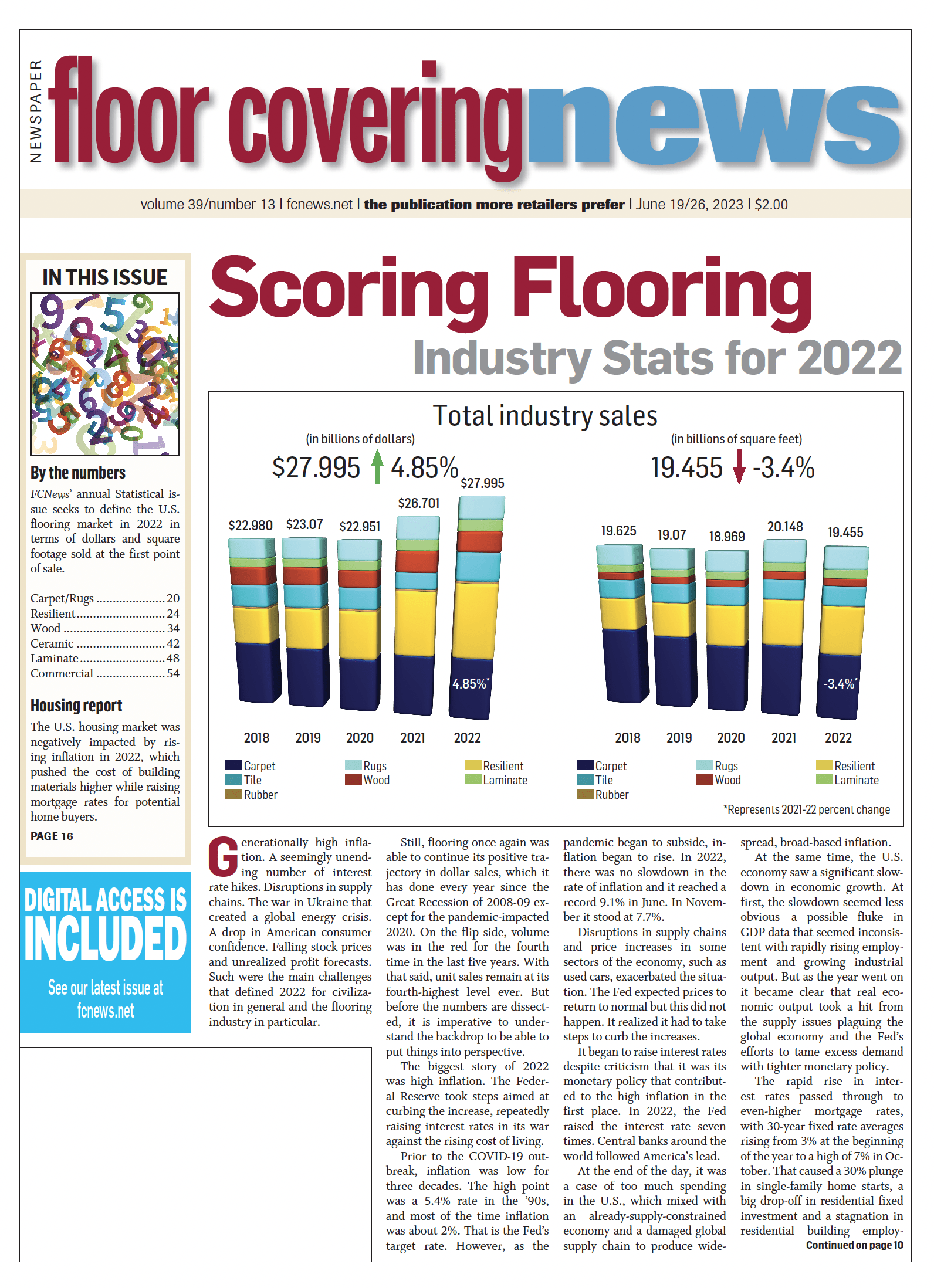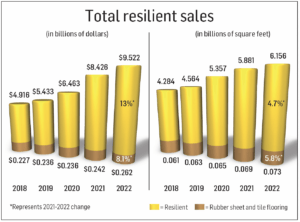 When the dust settled, Floor Covering News research found the resilient flooring category as a whole generated $9.522 billion in sales in 2022, a 13% increase over 2021’s $8.426 billion—much of that thanks to LVT. In terms of volume, the category accounted for 6.156 billion square feet (not including rubber) at the first point of sale, a 4.7% increase over 5.881 billion square feet in 2021. The discrepancy in double-digit sales growth vs. a single-digit volume increase is attributed to the unprecedented price increases in freight and raw materials as well as inflationary pressures in 2022 due to the lingering effects of the pandemic.
When the dust settled, Floor Covering News research found the resilient flooring category as a whole generated $9.522 billion in sales in 2022, a 13% increase over 2021’s $8.426 billion—much of that thanks to LVT. In terms of volume, the category accounted for 6.156 billion square feet (not including rubber) at the first point of sale, a 4.7% increase over 5.881 billion square feet in 2021. The discrepancy in double-digit sales growth vs. a single-digit volume increase is attributed to the unprecedented price increases in freight and raw materials as well as inflationary pressures in 2022 due to the lingering effects of the pandemic.
Most significant is that the resilient flooring category is now larger in terms of dollars than carpet (not including rugs) for the first time ever (by over $1.3 billion). What’s more, LVT (including residential and commercial rigid core and flex), now surpasses carpet by $10 million.
“Sales dollars were strong due to the multiple price increases that were implemented in almost every category in 2021 and 2022,” explained Whitney LeGate, vice president of commercial LVT and sheet, Mannington Commercial. “This led to stronger-than-expected sales dollars, but units did not grow at the same pace. We typically do not see pricing escalate that quickly or that many times in a short period of time, creating a unique circumstance.”
When taking total flooring sales into account, resilient gained market share in 2022. Resilient flooring comprised 34% of total dollar sales and 31.64% of volume compared to last year’s 31.6% of sales and 29.2% in terms of volume. In 2020, that number was 28.7% of dollars and 28.8% of volume, which was up from 24.6% of dollars in 2019. Looking back nearly a decade to 2014, resilient accounted for only 12.2% of dollars and 15.1% of volume. In essence, over these last several years, resilient’s share of the market has nearly tripled in terms of dollars and doubled in terms of volume.
Resilient’s strong performance in 2022 is even clearer when measured against the overall hard surface market. When compared to ceramic tile, hardwood and laminate, resilient accounted for 56.6% of dollar sales (and 58% of volume), up from 53.6% of dollar sales (and 55.9% in volume) in 2021; 50.6% in sales in 2020; and 45.1% in sales in 2019.
Of that 56.6% hard surface share, the LVT subcategory is by far the largest piece of the pie. Last year, LVT experienced a 14.1% increase in dollars to $8.262 billion and a 6.8% uptick in volume to 4.493 billion square feet.
Of course, it’s the rigid core subsegment of the resilient flooring category that is driving the overall growth—not just in resilient but for the industry as a whole. FCNews research found rigid core (SPC/WPC) garnered 60% of total resilient sales in 2022 and 47% in volume. That translates to $5.727 billion in sales and 2.87 billion square feet. Compare that to 2021 when WPC/SPC claimed just 45.6% of total resilient sales and 34.8% of volume ($3.845 billion in sales and 2.047 billion square feet.)
That growth in sales and volume is even more impressive when compared to 2020, when rigid core checked in at just $2.617 billion and 1.63 billion square feet. That means rigid core’s claim has essentially doubled in just two years. To put this in perspective, total LVT sales just eight years ago was $1.45 billion. So, rigid core alone is nearly quadruple the entire LVT market in 2015.
Rigid core’s command of the total LVT market is even more remarkable. In 2022, rigid core comprised 69% of total LVT dollar sales, or $5.701 billion of the total $8.262 in LVT (that includes LVT in both the residential and commercial sides of the business). Rigid core comprised about 76% of total LVT volume, or 2.766 billion square feet of the total 3.638 billion square feet of LVT.
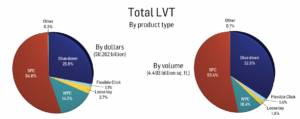
SPC comprises the lion’s share of that rigid core market. In 2022, SPC made up 47% of total resilient dollars sales, or $4.502 billion, and 39% of volume. That means SPC alone accounts for 55% of total LVT dollar sales and 53.4% of volume; and 80% of total rigid core sales and 84% of volume.
Much of that overall resilient flooring growth is attributed to both economic factors as well as the resilient product itself. What was impressive in 2022 is that growth didn’t just come from the residential side of the business. “We have seen an unprecedented increase in demand for resilient products in commercial applications over the past few years,” said Rick Morris, vice president of commercial hard surface, Shaw. “2022 was a record year for dollars and units. However, it was also a year of unprecedented inflation, which drove higher prices and, thus, an increase in dollars.”
In 2022, growth occurred in the first half of the year as the category continued to benefit from the boom in the housing market, which carried over from 2021. Once the second half hit, the category saw a slowdown (mostly in residential—the category’s workhorse) as interest rate hikes and price increases began to take hold. “We had very strong growth numbers coming into the year, but then you had the Fed raising interest rates quite steadily,” explained Adam Ward, vice president of product management, resilient, Mohawk. “With housing prices, mortgage rates, overall inflation more spending on travel and leisure, you saw [the category] slow down as we reached the summer into the back half of the year.”
Residential breakdown
FCNews research shows the residential market made up about 77% of total resilient flooring revenue or $7.29 billion, which is up from the previous year when it claimed 76% of total resilient revenue, or $6.407 billion in sales. That was a jump from 71%, or $4.847 billion in sales, in 2020. With respect to volume, residential resilient accounted for nearly 80% of square footage shipped, or 4.883 billion square feet. That’s compared to 4.114 billion square feet in 2020, when it claimed 76.8% of square footage shipped, for an increase of 18.7% in just two years.
The bulk of the resilient flooring category’s activity was driven by residential LVT (including glue-down, flexible click, loose lay, WPC and SPC), which generated an estimated $6.585 billion in 2022 versus $5.785 billion in 2021 and $4.25 billion in 2020. That’s a gain of more than 55% in just two years. In terms of volume, residential LVT accounted for 3.638 billion square feet, up from 3.417 billion square feet in 2021 and 2.835 billion square feet in 2020—that’s an increase of 28% in two years.
In terms of rigid core’s command of the residential LVT segment in which it resides (including both SPC and WPC), 2022 saw a whopping gain from 63.7% in dollar share to 84% in 2022. In terms of residential dollars, rigid generated $5.505 billion of the LVT market’s overall $6.585 billion in 2022.
While flexible LVT products (commercial) and WPC (residential) still commanded respectable shares of the market in 2022, it was SPC that again took the lead. FCNews research shows residential SPC (a subsegment of the rigid core subcategory) grew from 57.4% in total residential resilient dollars in 2021 to 59%, or $4.289 billion, in 2022. That’s compared to 52.1% in 2020. With respect to volume, residential SPC garnered 36.5% of total residential resilient square feet in 2022.
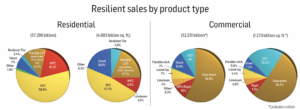
Suppliers agree the SPC subsegment of LVT is increasingly more attractive due to three primary features—performance, aesthetics and price of entry.
SPC’s sister-subsegment, WPC, saw a negligible decline in residential dollar sales and volume in 2022. FCNews pegs the category at $1.19 billion and 455 million square feet. That’s compared to $1.2 billion and 520 million square feet in 2021. WPC is almost exclusively imported from China, making it just as vulnerable to supply chain disruptions as any flooring category.
While SPC might be the little-brother bully to WPC, suppliers say WPC has value and a place within the residential market. “We believe in WPC,” said David Sheehan, vice president, residential hard surface, Mannington Mills. “It’s thicker—the consumer still equates thickness with quality and there’s some truth to that today—the product is not as rigid, not as brittle; the click systems are more robust; and it doesn’t get the complaints, claims or callbacks. So, we really enjoy WPC and the category did experience growth for us. Did it experience the higher, double-digit growth that SPC enjoyed? No. But it still grew and it’s a significant part of our portfolio—and will continue to be so.”
Flexible LVT products (including glue down, loose lay and flex click) continue to cede market share to the more popular rigid core subsegment. Of the total estimated $7.2 billion residential resilient market, flexible LVT garnered just 13.7%, or $998 million in dollars, and 17.7%, or 864 million square feet, in volume. On the bright side, flexible LVT held onto its share of the residential LVT market in 2022 compared to the previous year when it garnered 13.8% of the pie.
Glue-down products were the most sought after in the residential flexible LVT category, garnering $862 million in dollar sales and 779 million square feet in 2022. Some suppliers say residential glue-down still has its place. “As we all know, rigid core is great with regard to prep and installation time, but it’s not suitable for all installations,” said Bill Anderson, CEO, Karndean Designflooring. “Our glue down combines stylish visuals, durability and performance with the ability to create one-of-a-kind floor designs that aren’t possible with other [flooring] types.”
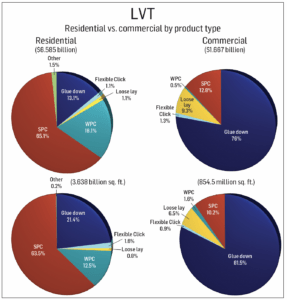
Flexible click and loose lay had similarly lackluster experiences in 2022 with flex click coming in at $70 million and loose lay at a mere $66 million. Compared to the total $7.29 billion residential resilient market—and even more starkly, the $9.522 billion total resilient market—category experts agree these subcategories are on their last legs.
In 2021, residential sheet surprised many when it generated a 13% gain in dollars and 5.4% increase in volume. In 2022, sheet garnered $513.5 million in sales (up 14%) and 968 million square feet (up 3.5%)—staying about flat in terms of market share when compared to 2021. The fourfold growth in dollars over volume is another illustration of inflation impacting resilient in 2022.
Suppliers agreed the subcategory was able to maintain its position due to its value proposition and domestic capacity. “A lot of 2021’s growth was driven by the fact that it was domestic and available—you just couldn’t get SPC,” Mannington’s Sheehan explained. “In 2022 it held its ground, and to hold your ground is progress. I think some people switched to it and they didn’t switch back. The year 2021 was the first year in many that we actually saw some growth in sheet—and to [maintain its market share] in 2022 is a momentous thing.”
Commercial breakdown
When it comes to the commercial market, the resilient flooring category generated $2.231 billion and 1.273 billion square feet in 2022 versus the $2.018 billion and 1.234 billion square feet in 2021. That’s compared to $1.756 billion and 1.253 billion square feet in 2020. In two years, that equates to a 27% gain in dollars. In terms of the overall commercial market, resilient accounts for nearly 31% of the overall pie ($7.34 billion).
For the commercial resilient flooring market, LVT is the star. The resilient subcategory (including flexible click, glue-down, loose lay and rigid) accounted for more than 75%, or $1.667 billion, of the $2.231 billion commercial resilient market. That’s compared to 2021’s 73.7%, or $1.487 billion, of 2021’s $2.018 billion commercial resilient market.
LVT, according to suppliers, continues to be specified across a range of segments and those specifications vary among the subcategories. “The proven performance of glue-down vinyl in commercial applications continues to make it the product of choice—with 2.5mm or 5mm depending on the application,” Shaw’s Morris explained. “However, rigid core floating products continue to do well and grow in hospitality, student housing and senior-living environments.”
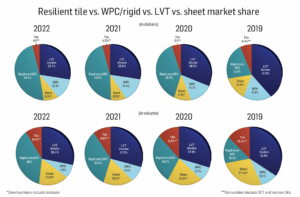
Within the LVT category, flex remains the favorite. FCNews research shows flexible LVT (including glue-down and loose lay) brought in $1.446 billion in sales and 758 million square feet. The sub-segment accounted for the bulk of activity with 65% share of the resilient commercial market’s $2.231 billion in sales and 60% of its overall volume. That’s compared to 62.1% share of sales and 57% of its overall volume in 2021. It’s up even more from 2020 when it garnered 61.6% in dollars and 53.6% in volume.
Of that overall LVT category, glue-down represented 76% of the $1.677 billion commercial LVT market and 82% of the 855 million square feet in 2022. That’s compared to 70.8% of LVT sales and 78% of volume in 2021. In terms of the overall commercial resilient market, glue-down represents 57% in dollars, or $1.268 billion. That’s an impressive 17.34% of the total commercial market.
“Glue down and loose lay are used much more than click products [in commercial],” Karndean’s Anderson said. “It all comes down to the specs of these products and performance. The concern with click products has always been holding up in commercial environments and the challenge of making repairs (having to unclick to replace a piece). That said, we are seeing more activity happening in Main Street with click products.”
Indeed, while glue-down is the main player in the commercial LVT market—and the commercial flooring market overall—rigid core continues to remain relevant. FCNews research shows rigid core represented 10%, or $222 million, of total commercial resilient dollar share ($2.231 billion) in 2022. Commercial rigid core flooring is mostly specified within the hospitality and multi-family segments where SPC’s performance features shine.
“Almost all of [our growth in 2022] came from LVT,” said Jeremy Whipple, vice president of commercial business, Novalis. “And the largest category in LVT, growth-wise right now, is SPC, the waterproof category. A lot of that is coming from multi-family and hospitality. SPC is just growing by leaps and bounds in hospitality. They appreciate the waterproof [capability]; they appreciate the sound performance. You add multi-family in there and SPC blows dryback away. Dryback has some steady growth but not the large growth that SPC does.”
The gain in the robust LVT category overall comes at the expense of other product categories, including VCT and linoleum. VCT garnered $200 million (up 2% due to price increases), or just 8.9% of the total commercial resilient market, in 2022. That’s compared to 9.7% in 2021, 11% in 2020 and 13.5% in 2019. Linoleum, on the other hand, garnered $111 million (up 8.8%) in 2022, just 5% of the total commercial resilient market. On the bright side, that was no decline for linoleum as it has garnered an average of 5% of total market share since at least 2020. The business has been dominated by Forbo for years.
Commercial sheet remained on its modest growth track in 2022 with a respectable 8% increase in dollar sales to $244 million compared to $226 million in 2021. Last year, the subcategory saw a more than 9% increase in both dollars and volume. In 2022, total sales equated to about 11% share of the total $2.231 billion commercial resilient market.
“Commercial sheet continued to perform well in 2022,” Mohawk’s Ward noted. “It has a strong position in healthcare. Mohawk got into commercial homogeneous sheet last year with our purchase of some of the Armstrong [assets]. We obviously saw that as a viable opportunity now and in the future.”
Commercial sheet is split into heterogeneous and homogeneous constructions. In 2022, heterogenous comprised nearly 65% of the commercial sheet market in terms of dollars and 62% in terms of volume. That’s up from 61.7% in dollars and 64.7% in volume in 2021, which were very similar to 2020 numbers. Homogeneous garnered just over $82 million in 2022, which is approximately 34% of the market.
“Heterogeneous felt like it did have a boost in 2022, but likely is still losing share to LVT and other flooring materials in segments like healthcare,” Mannington Commercial’s LeGate noted. “Homogenous sheet has been more stable and we have seen more growth as healthcare had growth, fueling that segment as well. It doesn’t appear to be losing share to other flooring materials as much as heterogenous. Likely due to the required sanitary use applications that homogenous products are well known for. The biggest challenge facing the sheet category is installation and the ability to have skilled labor to do the required work, including heat welding.”
Imports vs. domestic
The resilient category is heavily positioned as an import category mainly due to its reliance on imported products and/or raw materials. Rigid core is where the bulk of the growth is felt within the category and where sales continue to skyrocket. While some healthy product categories like sheet vinyl are made domestically, imports still far outweigh their domestic counterparts; however, the percentage of imports vs. domestics did shift in 2022 as new domestic capacity for rigid core came online.
“2022 was a significant year in that a fair amount of that domestic capacity came online, specifically in the world of SPC,” Mannington’s Sheehan said. “For us, we’ve been the one and only WPC producer here. Our domestic business has continued to increase and you had at least five to six additional plants come online in 2022 and a fair number of retailer and OEM opportunities began to take shape in 2022. So, whereas this category was probably 90%-95% imports, that shifted down to about 80%-85% in 2023. There was a significant amount of domestic capacity that began to ship into the market in 2022.”

